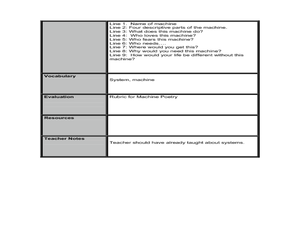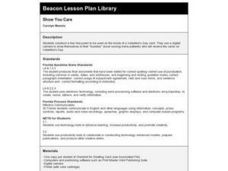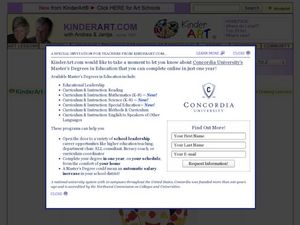Curated OER
Season Tiles: Ceramics Lesson
Each color holds its own feeling and these feelings are used to describe the four seasons. Youngsters create a color palate based on the four seasons, assigning various colors to each season. They each create four clay tiles, painting...
Poetry4kids
How to Write a Concrete or “Shape” Poem
Writers compose an original shape poem. Scholars choose a subject to write about and create a visual representation by forming a corresponding picture using the poem's words.
Curated OER
Collective Poetry: Teaching Tolerance
Help your class create collective poetry following a simple, engaging model from Teaching Tolerance (tolerance.org). Each young poet writes five things on an index card: sayings from others, favorite sound, favorite place, favorite...
Curated OER
Write Your Own Poem: Rhyming Word Pattern -end, -ind, -and
In this rhyming verse worksheet, students read 20 words in a chart and color them according to the directions, using a different color for each ending rhyme pattern. Students then answer 10 questions in which they write simple nonsense...
Curated OER
A Poem About Sadness
In this emotional health worksheet, students explore the feelings of sadness, grief and loss by first reading and decorating a poem which states that it is all right to feel sad. Students color emotion pictures and discuss as a group why...
Curated OER
Color My World
Students identify colors created by mixing primary colors and describe the process. They then design a book using the colors of a given season entitled "Colors of the Season".
Curated OER
Tricks of the Trade A Collection of Concrete Poems-for writing concrete poems
Students explore concrete poetry. In this lesson about poetry, students read A Poke in the I, by Paul B. Janeczko, and are introduced to concrete poems. Students read several different kinds of concrete poems including single-word, and...
Curated OER
Machine Poetry
Fourth graders write poems describing the relationship of machine parts. For this poetry writing lesson, 4th graders review a system and examples. Students discuss the systems individual parts and how they work. Students use the given...
Curated OER
Cracking the Mirror of the Past
Young scholars compare and contrast two pieces of artwork in regards to their nastalgic elements. Using the internet, they research local religious institutions in their area and note their function in society. They also compare and...
Curated OER
On a Hunt for Simple Machines
Fifth graders identify six simple machines. They brainstorm types of machines and complete a KWL chart. Students observe and explain six simple machines found in the classroom and in their home. They share their list with the class.
Curated OER
Tissue Paper Butterfly
Creating butterfly art is as simple as 1-2-3. Kids cut coffee filters into butterfly shapes. Next, they wet and place squares of tissue paper onto the filters. Fifteen minutes later, they lift the tissue to reveal a colorful pattern...
DLTK
Groundhog Paper Craft
Get crafty this Groundhog's Day with a hands-on activity that combines creativity and making predictions. Scholars color, cut out, and put together a friendly image of a groundhog and showcase whether they feel the weather will be sunny...
Curated OER
Twirly Whirly Milk
Student observe the effect soap (or detergent) has on the movement of food color in milk. Pupils observe the properties of solids and liquids while making butter. They read a poem, Shaking, and listen for ryhming words. Studdents...
Curated OER
Bugs
This is not just a worksheet, but an entire set of activities and worksheets that can accompany any unit on bugs or insects. Little learners will hone early math and literacy skills as they create mini-books, discriminate between big and...
Curated OER
Show You Care
Students construct a four-line poem to be used on the inside of a Valentine's Day card. They use a digital camera to show themselves to their "buddies" (local nursing home patients) who receive the cards on Valentine's Day.
Curated OER
Parts of Speech Poetry
Students replace nouns, verbs, pronouns, and adjectives in a poem. They identify the parts of speech, and rewrite the poem using their own selection of parts of speech.
Curated OER
M & M Madness
Second graders graph M & M's by color. In this graphing lesson plan, 2nd graders first predict how many of each color they think are in a handful of M & M's. Then they graph the amounts of each color on a computer program....
Curated OER
Nursery Rhymes
Learners recall details of nursery rhyme read by teacher, identify main characters, and demonstrate knowledge of poem by creating concept map about story that includes title, clip art, and changes in font and color.
Curated OER
Make a Birthday Card
Students use folded paper to design a birthday card to send to a famous person on their birthday paying attention to details such as borders and color. They then draw and label 10 things the person could receive as a birthday present.
Curated OER
Passionate Pilgrims- Two Poets And A Painter
Students engage in a lesson that looks at the culture of Japan to isolate the practices of painting and writing in several different traditions. They conduct research about the lives of the artists using a variety of resources. The...
Curated OER
Fruit and Vegetable Portraits
Learners create complex forms from simple items. In this portrait lesson, students examine the work of artist, Giuseppe Arcimboldo and compose self-portraits using vegetables and fruits as features on the face.
Curated OER
Nebraska's Wild Weather
Learners examine the weather in Nebraska. Using this information, they describe the cause and effect relationships in the environment based on these changes in weather. They write various types of poems with weather themes and share them...
Curated OER
Little Black Book
Young artists construct and create a journal. They develop the book using black construction paper, acrylic paint, glue, and tape. The art lessons from this source are among the best I've seen. The products produced by the students are...
Curated OER
Art and Literacy, grades 3-6, Reading Comprehension Category: Critical Stance
Students compare two very different works of art and two poems, and verbally list similarities and differences they perceive in the works of art and the poems; students then select poem that best correlates with a work of art.

























